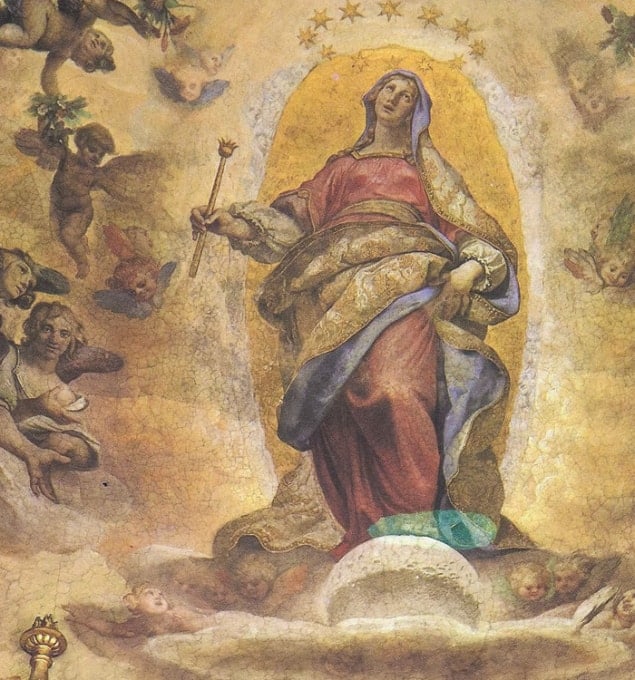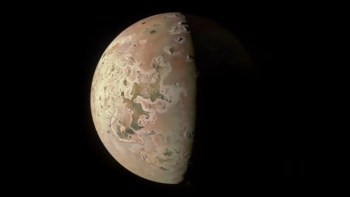Colliding Worlds: How Cutting-Edge Science is Redefining Contemporary Art Arthur I Miller 2014 W W Norton £22.00hb 352pp

In the autumn of 1610, the Italian painter Lodovico Cardi (better known by his professional name, Cigoli) began his most challenging work: a fresco to adorn the inside of the dome of the Basilica di Santa Maria Maggiore in Rome. Based on a biblical scene, the fresco depicts the Virgin Mary as the “queen of heaven”, standing on the Moon, wearing a multicoloured robe and carrying a sceptre, with a halo of 12 stars floating above her head. A closer look, however, reveals something new in Mary’s otherwise familiar pose: the Moon beneath her feet is pock-marked with numerous crater-like features. Cigoli, it turns out, was friends with Galileo, and historians believe he either looked through one of Galileo’s telescopes or at least closely perused Galileo’s Sidereus Nuncius, published just a few months earlier.
Cigoli’s fresco, then, is an early example of art drawing inspiration from science. It would not be the last. True, as science became more specialized, its practitioners tended to work in ever-narrower domains – but the bridge between art and science was never fully severed, and at the turn of the 20th century the links once again seemed to strengthen. At that time, both science and art were grappling with new ways of seeing the world, and it may be more than a coincidence that the application of non-Euclidean geometry to physics – notably by Einstein in his general theory of relativity – came just as painters such as Pablo Picasso and Georges Braque were experimenting with bold new ways of interpreting the world on canvas. The movement they founded, known as cubism, challenged traditional ideas of space and time – and echoed the latest developments in mathematics and physics.
The interplay between science and the arts in the early 20th century is a subject that Arthur I Miller explored in his earlier (very good) book Einstein, Picasso: Space, Time and the Beauty That Causes Havoc. Miller, an emeritus professor at University College London, has now turned his attention to the last 50 years, with a particular focus on the art–science scene today. Colliding Worlds bears witness to what Miller sees as a new phase in the history of art – one in which boundaries between disciplines have become blurred. Many of the artists Miller profiles have benefited from collaborations with scientists or engineers; a few of them are scientists themselves. One of the artists that he speaks with declares that today’s art “is an offspring of science and technology”.
In this entertaining, thorough investigation, we meet dozens of artists taking the field in a myriad of new directions. There’s Harold Cohen, for example, whose computer program, named AARON, produces much-sought-after abstract paintings; Katherine Dawson, who uses lasers to sculpt glass into biologically accurate depictions of the human brain; and Tim Otto Roth, who uses data from the Hubble Space Tele-scope to project “the heartbeat of the primordial universe” onto the sides of buildings. There’s no getting around the impression that a few of them are oddballs: ORLAN is an artist whose raw materials include her own skin cells; before meeting her, Miller received an e-mail from an assistant reminding him that her name is to be spelled in all capitals. But to be fair, the world of science has no shortage of oddballs either.
One question that looms in the background is whether the art–science influence flows in two directions or just one. Even the word “influence” is offensive to some artists. Miller recounts how, when chairing an art–science debate, he offhandedly used the phrase “science-influenced” to describe some of the artists taking part, and was immediately attacked by the panellists for suggesting “a hierarchy of disciplines – that science was above art”. It’s not clear how fruitful the evening was; as Miller writes, “The panellists seemed to know little of what went on in the world of science outside biology. This held for the audience, too, the vast majority of whom were artists.” At any rate, the impression one is left with after reading Colliding Worlds is that “influence” is a perfectly good word to describe what’s happening. Moreover, the influence is primarily, if not exclusively, one-way: whether the artists Miller has profiled will admit it or not, they are, in fact, deeply influenced by science, with little evidence to suggest a similar kind of influence going the other way. The book’s subtitle suggests Miller himself is sympathetic to this view, although he does record a small handful of exceptions. In one case, an encounter with an artist led a physicist to study the interaction between laser beams and soap bubbles; in another, a biophysicist was inspired to investigate artificial photosynthesis.
Miller also tackles a more difficult problem: can science explain the appeal of art? More generally, is there a scientific basis for aesthetics? He quotes from Richard Taylor, a physicist who is also an artist: science, Taylor hopes, will “throw a narrow beam of light into those dim corners of the mind where great paintings exert their power”. Yet there is, at this point, no consensus on the matter. Even trickier is the question of whether art and science are driven by similar motivations – perhaps, Miller suggests, by a quest for symmetry, or, more generally, for “beauty”. A fully satisfying answer is too much to hope for, especially given how hard it is to even pin down definitions of “art” and “science” that everyone can agree on; ultimately Miller leaves the issue unresolved. (Even so, an analysis of Jackson Pollock’s drip-paintings, said to exhibit a fractal structure, makes for a fascinating intermezzo mid-way though the book.)
It’s hard to doubt Miller’s assertion that a new art movement is blossoming. He presents more than enough examples to make the case. Yet his prediction that art and science are on their way to a merger – an argument he mounts in the book’s final pages – must be taken with a grain of salt. Although both art and science will surely surprise us in the years and decades ahead, I suspect they will surprise us in their own, separate ways.



